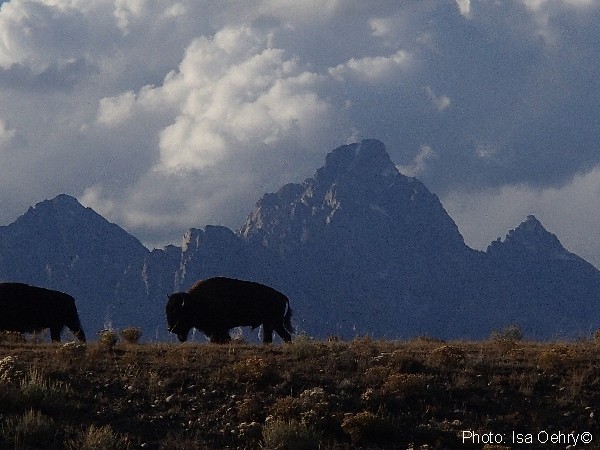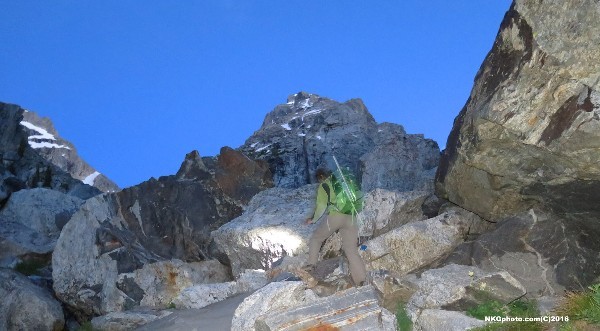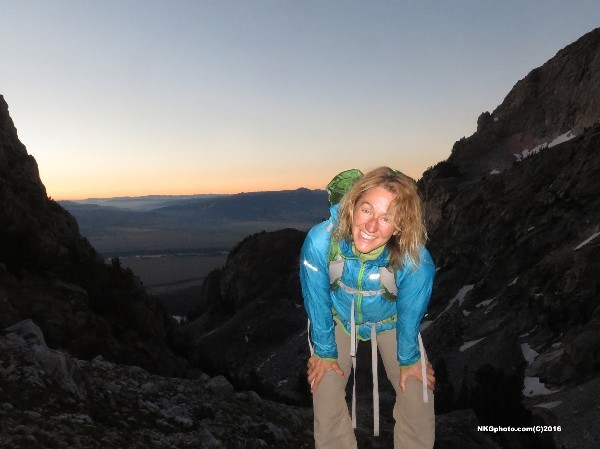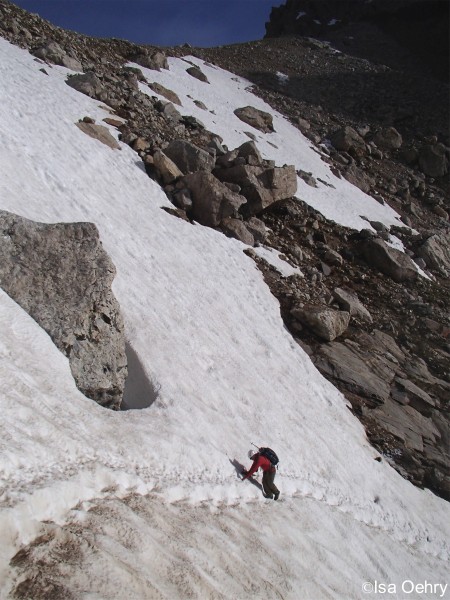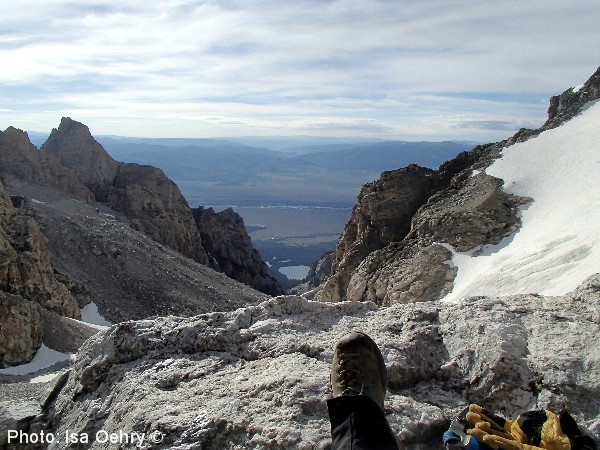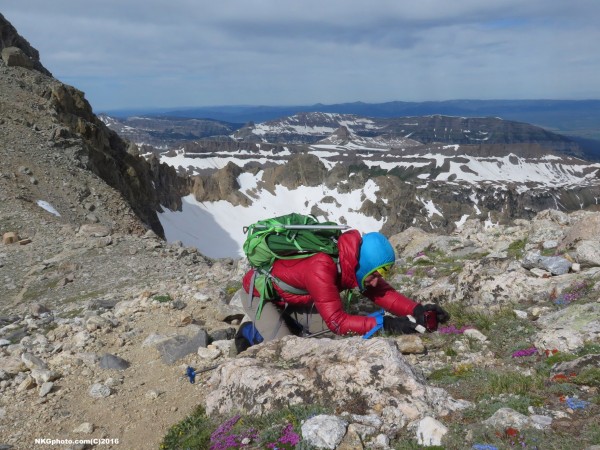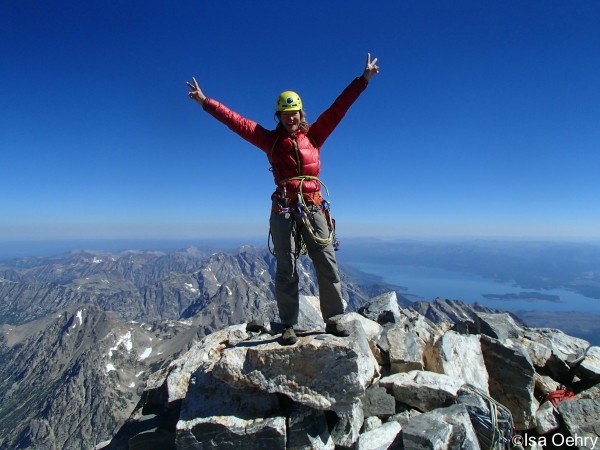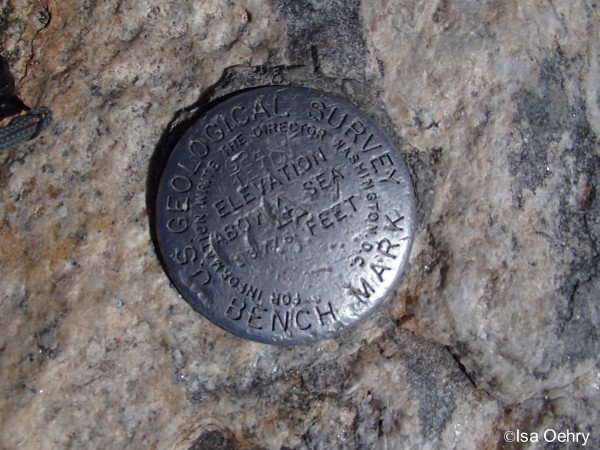Three years ago I stood at the same spot – the beginning of the Garnet Canyon Trail – heavily loaded down with food, water, camping gear, and all climbing equipment necessary to ascend the Grand Teton. I had been harboring a secret love affair with this magnificent peak since I saw a picture of it as a kiddo. In this picture the 13,770 foot tall Grand, located in the Grand Teton National Park in Wyoming, towered far above its neighboring peaks, majestic and stoic. It drew me in like a magnet.
The Garnet Canyon Trail is more than six miles long and ascends over four thousand feet onto the Lower Saddle of the Grand. Often climbers choose to bivouac here and attempt to climb the remaining 2,200 feet of elevation gain the following day. The Jenny Lake Rangers website states that it is not uncommon for parties to take 14 hours or more to make the round trip already starting at the Lower Saddle. Three years ago, while bivouacking on the Lower Saddle, winter had made an unannounced arrival and had glazed the Grand with a beautiful but unclimbable veil of ice for us. The dream of summitting had slipped away during that night.
Since then, I had had ample time to contemplate another attempt. I had read about climbers’ successes and failures, opinions on gear improvement and suggestions on weight reduction. I had also read about ascents in a single day – car-to-car – by what the guidebooks refer to as ‘very fit’ climbers. While I was in ‘decent’ shape, my heydays of being a top athlete had long been replaced with years of motherhood and deskwork. Still, I was eager to try again – this time car-to-car. It was easy to convince Nick, my partner in crime when it comes to anything vertical, of doing a single-day push with small, feather light packs.
It was two o’clock in the morning when Nick and I stood at the beginning of the Garnet Canyon Trail. I carried a rope while Nick carried a minimal gear rack. We had water filters to allow us to drink directly from brooks. Instead of my traditional mountain fare of a loaf of bread and a pound of cheese, we had energy bars and goop. Our climbing harnesses were replaced with super light mountaineering harnesses, and we left our climbing shoes behind hoping to ascend the Grand in approach shoes. Upon recommendation by rangers, we also left our crampons behind and each of us only carried an ice axe.
We began our hike under a canopy of millions of stars and made good progress, arriving at the Meadows at 9,300 feet by sunrise. After we ascended the switchbacks to the Middle Teton Glacier Moraine we worked our way to a snowfield below the Lower Saddle. Since the traditional approach with fixed ropes was still buried below snow, we had to traverse the precariously steep snowfield. We had been informed that the snowfield could be crossed without crampons, as temperatures had been warm during the past days, but in the early morning hours the crossing had frozen to sheer ice. Without crampons our shoes had no solid footing. This was dicey. Nick and I set out moving with extreme caution. Traversing the icy snowfield with only one ice axe each took intense concentration and much longer than anticipated, but we finally reached the Lower Saddle at eight o’clock with a huge sigh of relief. There was enough time left in the day to attempt a push to the summit.
When we began the arduous hike to the Upper Saddle, I noticed that Nick’s movements had slowed and his color was all but ash gray. We were at 11,600 feet and he was not feeling well. I suggested a rest to adjust to the altitude. Meanwhile I took pictures of precious alpine flowers. Not long after, Nick begifted these flowers with his breakfast – projectile vomiting style. He was sick. Not knowing much about altitude sickness, I encouraged him to push on. He might get better and the two of us would fulfill our dream of reaching the summit. I pointed to the black dyke, a landmark at 12,200 feet, and encouraged him to try to reach it. There we would rest again and regroup. A good sport, and not wanting to give up his dream, he pushed on, vomiting multiple times. He lost all food and hydration. We had to return to a lower elevation. From my first attempt, three years ago, I was already familiar with the sinking feeling of turning my back to the Grand without summitting. For Nick it was a first attempt, and a huge disappointment.
Two weeks later we were back. We knew the drill. Light packs, granola bars and goop, to bed at six p.m., up at one for an early two a.m. start. The only problem was, it was late July, and it was hot - too hot to sleep. We tossed and turned in the van, which had been our home for several weeks already, unable to fall asleep. By ten o’clock I announced that I could not climb the Grand car-to-car on only three hours of sleep. We had to postpone. After the decision was made, we promptly fell asleep.
The next day temperatures were cooler and we tried again. This time we slept and were on the trail as planned at two a.m. We hiked swiftly, arriving at the Meadows even before sunrise. With each step I felt lighter and lighter, enjoying the ease of my load, and the freshness of the night air. I was thrilled to be back, now for the third time. Nick on the other hand began to feel nauseated and not long after arriving at the Middle Teton Glacier Moraine got sick again. Since our last climbing attempt, I had learned that the only effective remedy for altitude sickness is to return to a lower elevation. As we rested and let reality sink in, a hiker approached us. He walked with a solid and steady gate, and had the look of a man who had experience in the mountains. As he passed, a quick conversation confirmed that indeed the only remedy for altitude sickness was to retreat. Nick was devastated. Knowing however that I was feeling well and energized, he encouraged me to go on. If I was lucky, I could join another climbing party and make the summit. If nothing else I could summit the Enclosure Peak, a magical peak at 13,285 feet and the high point of my summit attempt three years ago. I knew the way and technical climbing was not necessary to reach this peak.
Grateful for Nick’s support, I gave him a big hug, took the climbing rack from his pack, and continued on. I knew he would be fine returning to the Meadows on his own. Hundreds of times I had imagined the two of us on the summit together. Now I found myself forging ahead with the prospect of sharing this monumental experience with complete strangers should I be lucky enough to find a willing team. I remembered the mountain man who had passed us earlier. He had been alone and had carried only a small daypack, probably without technical climbing gear. I had all the gear for a team. If I could catch him, would he join me?
I had a glimpse of him crossing the snowfield below the Lower Saddle. I increased my pace and finally met up with him while he rested at the Exum hut. He was a quiet man, words only spoken with purpose, a stark contrast to my excited bubbling speech as I filled him in on my plan. Besides my many questions, not a word of beta slipped his mouth. He remained tight-lipped about any climbing route information, probably thinking that I was yet another wacky tourist who will need a rescue later in the day. After a short rest he began the hike to the Upper Saddle. I was just one step behind him, like one of Konrad Lorenz’s goslings, firmly ‘imprinted’ on the first large moving object the goslings see after hatching. Feeling a bit guilty, I finally asked if he would mind the company. He responded softly that company might be enjoyable. During our evolving conversation and only due to my insistent probing, I learned that he had summited the Grand many times and had in fact put up several routes in the park and other places around the country. I felt giddy with delight, wanting to somersault with joy. What fortune to find this experienced and seasoned mountain man – a perfect climbing partner.
While hiking, we spoke about life. We discovered that we both looked at life as an adventure and taking risks as a welcomed spice. We talked about pushing oneself beyond the zone of comfort as the only way to gain experiences and to grow. We both agreed, that even if united in love or marriage, life was still a solo adventure. I was surprised and delighted by his views. I had found a like-minded soul.
While hiking quietly, he seemed deep in thought. Suddenly he mentioned an accident that had happened the previous day. It was a rappelling accident, he explained. I knew that it was dangerous to rappel the mountain with a single rope, which is all I had, but I knew it could be done. He offered no further explanation and I imagined that a climber had missed the end of the ropes by a couple of feet and had possibly twisted an ankle, causing a rescue. I made a mental note not to forget to make knots in the ends of my rope before rappelling.
Finally, we arrived at the Upper Saddle, the point where the path splits between the technical climbing of the Grand and the Enclosure Peak. Here, the mountain man suddenly announced: “Isa, today you will summit the Grand!” I was overjoyed. We would climb and summit as a team. Then he looked at me and declared to my utter surprise that he would continue on to the Enclosure Peak. Somehow I must have earned his trust however because he went on to explain the various crucial sections of the technical route I planned to climb. He wished me good luck as we shook hands and went on his way.
Totally stunned, I found myself alone. I remembered our conversation. Life was a solo adventure and it takes courage to step outside one’s comfort zone. The mountain man knew all along that he would not summit the Grand. But in a gentle way he had encouraged me to take the risk. I carried his calm and quiet confidence with me as I hiked up to the beginning of the Owen-Spaulding route. I had soloed easy and some moderate ice climbs, but I did not consider myself a solo climber. I knew, however, that the technical difficulties of the Owen-Spaulding route should not present a problem. It was the sheer exposure that could rattle the nerves. Climbing unroped over thousands of feet of vertical abyss, overlooking the Black Ice Couloir and the Valhalla Canyon, demanded calmness and focus.
I promised myself that I would not proceed should I be unable to reverse my steps. I put on my climbing harness, clipped a few pieces of protection on slings in case I needed a rest, and tied the rope to my back.
The Owen-Spaulding route begins with the famous “belly crawl,” a ledge squeezed by an overhanging wall obstructing the view of the climb. I plugged in a Camelot and leaned out to have a look. Once I could see the ledge, I quickly moved out onto its face, removed the protection, and began the airy traverse. The exposure was dizzying. I reminded myself to keep my focus on the rock and not on the abyss below. I moved with ease, enjoying the freedom of not being tied to anything. A double chimney, the crux of the route, follows the belly crawl. Even though it is technically not too difficult, ascending its huge flake, jammed inside the chimney, requires some intricate moves. I marveled at the skills, which guides must possess, to safely protect often-inexperienced clients on this route.
I did come upon a team of climbers high in the Owen Chimney. After I greeted them, they hollered that the chimney was iced over. When I asked if it was okay for me to climb up and have a look, they willingly invited me. There was indeed ice in the chimney, but the climbers were able to use the existing pitons for protection. All geared up, they were enjoying a winter experience in July. I climbed around them on dry rock and proceeded to the very large Sargent’s Chimney. I moved swiftly through the chimney, once again feeling an indescribable bliss combined with the enjoyable freedom of movement and an appreciation for the speed that solo climbing allows. A friend once mentioned, that when you are finally on your life’s path, instead of experiencing a struggle, it would feel as though angels were pushing you forward and you could hardly keep up. Of course, she had meant it with regards to a career and not such silliness as climbing big mountains. Still, I felt propelled by an unseen force, uplifted and energized with each step, fearless and confident. Trail angels are what my friend had called them.
After the Sargent’s Chimney, I reached the upper slabs that lead to the summit. Climbing books warn about paying close attention here, as the same path will be needed for descending and is difficult to find on the way down. Many accidents occur on this part of the climb, which was a concern for me. But for now, I wanted to first enjoy the peak.
When I reached the magnificent summit I climbed onto the highest rock, which had a geological survey benchmark indicating the very top of the Grand. Standing on it, I turned around in a circle, arms outstretched, deeply breathing in the air, and marveling at the stunning view. With the Grand being the highest point of the Grand Teton Range, and with no other mountain range in sight, standing on the very top of it feels like standing on top of the world. After two unsuccessful attempts, I had finally summited. It was exhilarating!
Just as I had reached the top, a team of three young climbers approached from the direction of the Exum route. We quickly became friendly as is common among climbers. I felt an incredible appreciation for their presence. I had been unsure of the descent, but these young men had been here before and would know the way. I offered to tie our ropes together for the rappel but they declined and instead offered me the use of their ropes. We safely rappelled back to the Upper Saddle where I had begun my solo climb. I thanked them for their generosity. As I watched them begin the long climb down to the Lower Saddle I could not help but think of trail angels. These young men had come out of nowhere, assisted me safely back onto solid ground, and then left. I suddenly realized that the mountain man had done the same thing. He had appeared, had inspired me and filled me with confidence, and then he was gone.
Slowly, I began the descent to the Lower Saddle. I was filled with an overwhelming sense of joy, gratitude, wonder, and appreciation. I had stood on top of the Grand – finally!
The Lower Saddle was a welcomed point of rest. It was here that I had spoken with the mountain man while he had lingered at the side of the Exum hut. I would eventually proceed to finish my car-to-car ascent of the Grand in a little over sixteen hours. Before I continued, however, another climber informed me that an Exum mountain guide had fallen to his death on the Owen-Spaulding route just the previous day. While guiding clients, he had fallen 2,400 feet from the rappel into the Valhalla Canyon below. The somber news shattered my joy. I sat down next to the hut and took a moment to take in what I had learned.
Suddenly I understood. The mountain man had rested here to remember his friend – the guide - and had come to climb the Enclosure Peak to honor him. The Enclosure Peak is believed to be a site where Native Americans had once performed sacred ceremonies on its peak. The mountain man knew that if he would tell me that the accident of his friend just twenty-four hours earlier on the Owen-Spaulding route had been fatal, I would not be able to go on and climb the route. Instead, he kept his sorrow to himself and encouraged me on my journey – a true trail angel.
As I sat next to the Exum hut, I climbed every step of the route again in my mind. I envisioned putting my fingers where the guide had put his fingers and stepping with my shoes where he had left invisible footprints. I remembered looking down into the dizzying abyss of the Valhalla Canyon, unaware of the devastating secret it held. I relived the joy of being on the summit and felt his joy, a fellow climber, with whom I share the love for the mountains and the passion for climbing. I felt again the incredible uplifting energy. It was as if someone had grabbed me under my arms and had pushed me – higher and higher – while protecting me from harm.
Trail angels had assisted me along my journey but a real angel – a real climbing pro – had graciously guided me, I was certain, while I soloed the Grand.
This encounter happened in July 2016 and was not published for one year out of respect to the guide and his family.
Isa is the author of "Under a Blue Moon." More information: www.isaoehry.com
